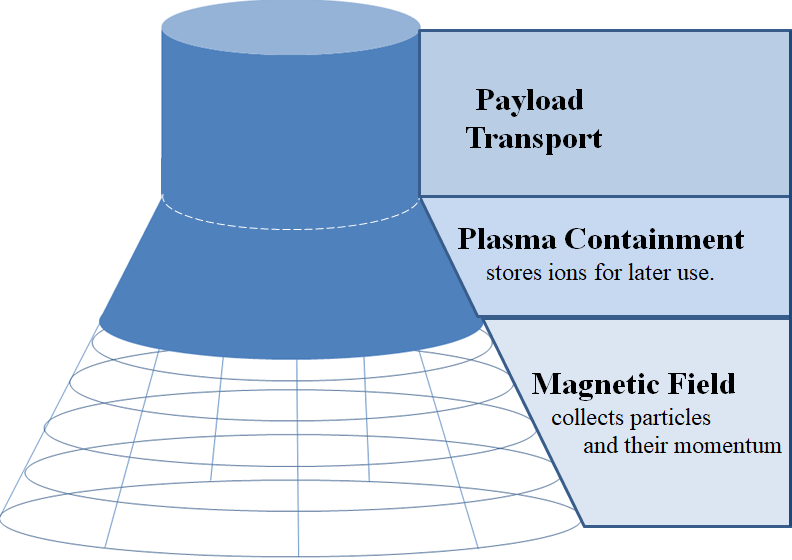LIFEBOATS
| VOLUME 0: ELEVATIONAL |
|---|
| VOLUME I: ASTEROIDAL |
| VOLUME II: INTERPLANETARY |
| VOLUME III: INTERSTELLAR |
Since Space Elevator (SE) tether ribbons will inevitably rip, it makes excellent good sense to plan emergency return capabilities.  For some scenarios, consider a "lifeboat". Thot Experiment (TE) brainstorms another type of vehicle to safely return payload back to Earth's surface. Preferably, it will land precisely at the "base station" at the bottom of the tether.
For some scenarios, consider a "lifeboat". Thot Experiment (TE) brainstorms another type of vehicle to safely return payload back to Earth's surface. Preferably, it will land precisely at the "base station" at the bottom of the tether.
ASSUMPTION: Tether remains intact. This chapter assumes tether sustains damage but remains intact. Thus, tether is still taut, but vehicles cannot safely traverse damaged area (i.e. "rip"). In another chapter, TE proposes tether will host numerous nanobots to expeditiously repair any rips; however, practicality compels us to assume that such repairs will take a while and will need testing prior to subsequent climber traffic.
ASSUMPTION: Tether remains intact. This chapter assumes tether sustains damage but remains intact. Thus, tether is still taut, but vehicles cannot safely traverse damaged area (i.e. "rip"). In another chapter, TE proposes tether will host numerous nanobots to expeditiously repair any rips; however, practicality compels us to assume that such repairs will take a while and will need testing prior to subsequent climber traffic.
NOTE: "Severed tether" would have global impacts, and the safe return of climbers would become a trivial priority. Thus, this concern is discussed in a later chapter.
If rip is above climber , it might continue a tenuous descent to surface if the ribbon maintains sufficient tension.
The option to dismount the ribbon and free fall to the surface would be very useful. |
If rip is beneath, operators might wish climber to release tether and free fall to surface.
Perhaps a combination of jet packs and chutes might safely cushion impact at surface. |
If far from Earth's surface, a vehicle configured only for tether attached travel cannot safely free fall to Earth's surface; thus, it must return to GEO Node. HOWEVER, passengers and payloads may need to evacuate while tether is still in disrepair; thus, climber needs to transform into a space borne lifeboat.
Replace Down-Link Tether with Particle Beam. ① As vehicle approaches Earth, gravitation force grows from .05 g to 1g at surface. ② Earth bound particle accelerator sends high speed, particle beam upward to slow vehicle down during final portion of descent from GEO Node. | Upon departing GEO Node, TE assumes free falling lifeboat's linear velocity toward Earth increases from 0 to about 15 kps just before impacting surface. Since 15 kps is way too fast, the lifeboat will need a reliable method to slow down for a safe impact. |
| Wikipedia Article: Bussard Ramjet |
If rip is above climber, climber reverses direction to return to base station. | it might continue up if GEO Node offers safe haven. |
Occupants of Up-Link's GEO Node might need to return to Earth before the ribbon repair is complete. The traditional return route involves the Cross-Link shuttle to Down-Link's GEO Node to take Down-Link climber on 7 day tether trip back to Earth. |  Instead of Down-Link climber, the lifeboat provides a much quicker trip back to Earth. Lifeboat would accelerate via increasing Earth gravity back to lower LEO; then, 1G decelerate via a particle beam for a zero velocity return at Earth surface. Definitely quicker, the lifeboat is likely much safer.
Instead of Down-Link climber, the lifeboat provides a much quicker trip back to Earth. Lifeboat would accelerate via increasing Earth gravity back to lower LEO; then, 1G decelerate via a particle beam for a zero velocity return at Earth surface. Definitely quicker, the lifeboat is likely much safer.
|
CONCLUSION:
Perhaps Down-Link physical tether is not needed!
|

0 Comments:
Post a Comment
<< Home